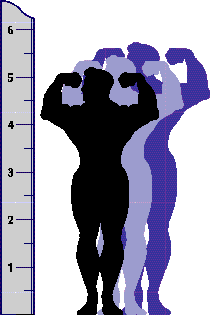Steroid Prevention Program Scores with High School Athletes
Download PDF Version What is PDF?
Robert Mathias
Robert Mathias is a Staff Writer for NIDA NOTES.
Source: NIDA
NOTES, Vol. 12, No. 4, July/August
, 1997
Public Domain
Table of Contents (TOC)
Article: Steroid Prevention Program Scores With High School AthletesReferences
A NIDA-funded drug abuse prevention program is showing high school football players that they do not need to take anabolic steroids to build powerful muscles and improve athletic performance. By educating student athletes about the harmful effects of anabolic steroids and providing nutrition and weight-training alternatives to steroid use, the program has increased football players' healthy behaviors and reduced their intentions to use steroids.
Until now, anabolic steroids, drugs derived from the male hormone testosterone, have rarely been the focus of drug abuse prevention studies, says Dr. Ro Nemeth-Coslett of NIDA's Division of Epidemiology and Prevention Research.
 Student athletes in the ATLAS program learn that stunted growth and many other harmful effects can result from steroid use.
Student athletes in the ATLAS program learn that stunted growth and many other harmful effects can result from steroid use.
This may be because steroids are not widely abused. Only about 2 percent of 8th, 10th, and 12th grade students have ever used steroids, according to the NIDA-supported Monitoring the Future study for 1996. However, steroid abuse occurs more often among young people who are involved in physical training because anabolic steroids can increase muscle mass, strength, and stamina, Dr. Nemeth-Coslett points out.
Although adolescent boys, particularly those involved in athletics such as football or body building, make up the majority of high school steroid users, national surveys show that adolescent girls also are vulnerable to the lure of steroid use. (See Adolescent Girls Abuse Steroids, Too) However, that lure contains a hook - anabolic steroid use can have severe physical and emotional consequences for both males and females. Physical effects can include stunted growth, high blood pressure, and liver tumors. Psychological effects can include wide mood swings that range from episodes of uncontrolled anger and aggressiveness to clinical depression when steroid use is stopped. (For more information, see Questions and Answers About Anabolic Steroids.)
 "The Adolescents Training and Learning to Avoid Steroids (ATLAS) program
uses a team-oriented educational approach that motivates and empowers
student athletes to make the right choices about steroid use," says
Dr. Linn Goldberg of Oregon Health Sciences University in Portland,
who led the research team that developed and tested the program. The
program consists of classroom, weight-training, and parent information
components. Together, they give student athletes the knowledge and skills
to resist steroid use and achieve their athletic goals in more effective,
healthier ways, he says.
"The Adolescents Training and Learning to Avoid Steroids (ATLAS) program
uses a team-oriented educational approach that motivates and empowers
student athletes to make the right choices about steroid use," says
Dr. Linn Goldberg of Oregon Health Sciences University in Portland,
who led the research team that developed and tested the program. The
program consists of classroom, weight-training, and parent information
components. Together, they give student athletes the knowledge and skills
to resist steroid use and achieve their athletic goals in more effective,
healthier ways, he says.
In ATLAS's classroom component, football coaches and student leaders conduct seven highly interactive sessions that explore the effects of steroids, the elements of sports nutrition, and strength-training alternatives to steroid use. These classes also hone the athletes' decision-making and drug-refusal skills. In a typical session, the football team is split into squads of six or seven students, with student squad leaders conducting the sessions and teaching most of the intervention, according to Dr. Goldberg. "It's kids talking to kids; that's an important ingredient in our program," he says. Coaches, who have a substantial influence on these student athletes, also play an important role on the steroid prevention team, Dr. Goldberg says. Coaches introduce topics and wrap up each session, he explains.
"The ATLAS program is voluntary, and students get no credit for it, so it better be entertaining," he says. As a result, ATLAS classroom sessions are designed to combine fun and games and learning. Coaches move from squad to squad and introduce a topic, such as the effects of anabolic steroids. Then squad leaders take over and initiate an action game that incorporates the topic. For example, players may toss a football to each other as they answer questions about problems that stem from steroid use. "Although they are playing a game, each one is paying attention and listening because someone is flipping the ball to them," says Dr. Goldberg. "No one is saying to them, 'Watch out, steroids cause liver disease, acne, and so forth,'" he notes. "But while they are laughing and having a good time, they are actually watching and learning at every step of the way."
"Football players are athletes; they like to compete," Dr. Goldberg notes. Therefore, several games pit squads against each other to try and earn the most points for correct answers about weight training, nutrition, and steroids. In addition to games, "students do mock public service announcements, they do 'rap,' they do songs, and they do newspaper articles in the classroom sessions," he says.
Adolescent Girls Abuse Steroids, Too
What do anabolic steroids have in common with amphetamines, tobacco, diet pills, laxatives, and anorectics? They all are drugs used by adolescent girls seeking to stay thin, says Dr. Linn Goldberg of Oregon Health Sciences University. The use of these drugs, which often goes hand in hand with eating disorders, is particularly prominent among adolescent girls engaged in athletic activities ranging from track and field, soccer, basketball, and volleyball to school dance and drill teams, Dr. Goldberg says.
Dr. Goldberg and his colleague Dr. Dianne Elliot have been conducting preliminary research, funded by NIDA, to identify risk factors that influence adolescent girls use of harmful drugs. Among other things, the researchers have found that many adolescent girls use drugs to maintain thinness, Dr. Goldberg says. National surveys indicate that girls account for about one-third of the high school students who abuse steroids, Dr. Goldberg says. The primary reason that these girls use steroids is to lose fat and gain lean muscle, he says.
Dr. Elliot and Dr. Goldberg have already developed an effective steroid prevention program for male high school athletes described beginning on the previous page. Now, they are developing a similar drug abuse prevention program for adolescent girls. In their future research, the researchers hope to test the effectiveness of the intervention in reducing drug use and eating disorders among female athletes in Oregon's public middle and high schools.
In ATLAS's weight-training component, research staff members conduct seven hands-on sessions that teach the students proper weight training techniques. These sessions are designed to help student athletes build the muscular strength and agility needed to achieve their athletic goals without using steroids.
In the parent information component, parents participate in an information and discussion session about the program with the ATLAS staff. The staff gives the parents a family sports nutrition guide and encourages them to support and reinforce the antisteroid and nutritional goals of the program at home. Students in the program say their parents are more opposed to steroid use after the intervention and often provide healthier meals at home, according to Dr. Goldberg.
Late last year, Dr. Goldberg reported results of an ongoing study of ATLAS's effectiveness in preventing steroid use among more than 1,500 football players from 31 high schools in the Portland area. Some 702 football players at randomly selected schools received the 7-week program during football season. Another 804 football players at matched schools served as a control group and received only a standard informational brochure on the dangers of steroid use.
 Assessments conducted immediately after the intervention and 1 year
later show that, compared with control students, student athletes who
participated in the ATLAS program knew more about exercise, nutrition,
and the harmful effects of anabolic steroids. ATLAS participants also
had an increased sense of personal vulnerability to negative effects
of steroids, more unfavorable attitudes toward their own and others'
use of steroids, and reduced intent to use steroids. ATLAS students also
showed greater improvement in their nutritional habits than did control
students. For example, they were more likely to eat high-protein low-fat
meals at school, home, and fast-food restaurants. In addition, ATLAS
students were more likely than students who did not participate in the
program to use established weight-lifting and strength-conditioning techniques.
Assessments conducted immediately after the intervention and 1 year
later show that, compared with control students, student athletes who
participated in the ATLAS program knew more about exercise, nutrition,
and the harmful effects of anabolic steroids. ATLAS participants also
had an increased sense of personal vulnerability to negative effects
of steroids, more unfavorable attitudes toward their own and others'
use of steroids, and reduced intent to use steroids. ATLAS students also
showed greater improvement in their nutritional habits than did control
students. For example, they were more likely to eat high-protein low-fat
meals at school, home, and fast-food restaurants. In addition, ATLAS
students were more likely than students who did not participate in the
program to use established weight-lifting and strength-conditioning techniques.
"The program's positive effects flow from changing the student athletes' attitudes and perceptions about steroids and then changing their nutrition and exercise behaviors," Dr. Goldberg says. These changes in behavior are reinforced by conducting periodic tests of the athletes' body composition, strength, and power. "If they are training properly, they are a heck of a lot stronger. So, it's real positive reinforcement to them," he says.
"Student athletes who participate in the ATLAS program achieve," Dr. Goldberg says. The year before they entered the program, the football teams that were randomly assigned to receive the intervention had much worse won-lost records in football than the teams in the control group had, he says. At the end of the first year, the two groups' records were about the same, but teams in the ATLAS program did slightly better. At the end of the second year, the won-lost records of the ATLAS teams were substantially better than those of the control teams, with some of the ATLAS teams making the playoffs at the end of the season. "I don't know whether these teams' improved performance is due to the ATLAS program," Dr. Goldberg says. "I do know some of those schools hadn't been to the playoffs in 25 years. The data showing improvements in program participants' body composition and muscle mass are consistent with these teams' success," he says.
Goldberg, L.; Elliot, D.; Clarke, G.N.; MacKinnon, D.P.; Moe, E.; Zoref, L.; Green, C.; Wolf, S.L.; Greffrath, E.; Miller, D.J.; and Lapin, A. Effects of a multidimensional anabolic steroid prevention intervention: The adolescents training and learning to avoid steroids (ATLAS) program. JAMA 276(19):1555-1562, 1996.


